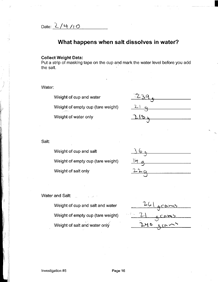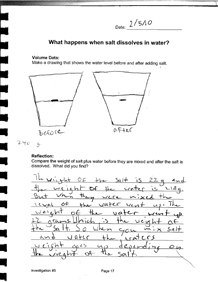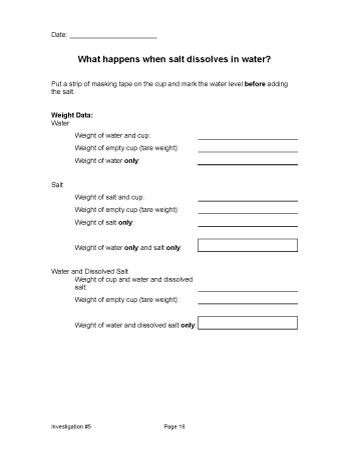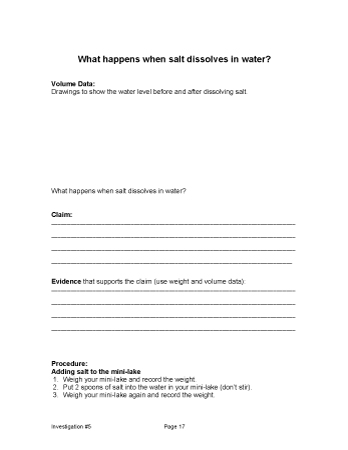What changes and what stays the same when salt dissolves in water?
Plan Investigation 5
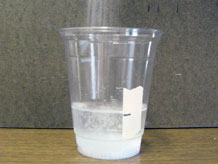
Students are becoming more experienced thinkers about the weight of small pieces of matter such as drops of waters. Today they consider even tinier pieces of matter - minute grains of crushed salt.
Start with a single grain of typical table salt. Divide it into a billion equal-sized pieces, and then divide just one of those billion pieces into a billion equal-sized pieces. If you do this carefully, each of those smallest pieces will be the size of a single molecule of sodium chloride, the substance we call salt. Is a molecule of salt smaller than you thought? Do you think it weighs anything?
Yes, the 4-pound box of table salt has weight because each of the more than 22.5 million grains of salt in the box has weight, and each of the grains has weight because each molecule of salt has weight. This unit does not address the concept of molecules, but it does continue one important idea that students have been building over the past few sessions: very tiny things have weight.
Formative Assessment
Available online at inquiryproject.terc.edu
Have your students collected accurate weight and volume data that they use to support a claim about what happens to salt when it dissolves in water?
Look for evidence in the notebook entries. What happens when salt dissolves in water? Without accurate data, students will be unable to support claims that dissolved salt is present in the water even though it’s invisible.
Use these criteria to interpret students’ work:
- Is the weight of water alone plus the weight of the salt added equal to the weight of dissolved salt and water?
- Does the drawing of volume data show that adding salt increases the water level?
Once students have collected and recorded accurate data, the next step is to ask them to make claims about whether dissolved salt still exists in the water even though you can no longer see it, and to use the weight and volume data they just collected to support their claims.
Today we extend the idea that there is power in numbers. When students grind up kosher salt, the size of each piece decreases but the number of pieces increases; the weight does not change. The same thing happens when dissolving salt in water: the pieces become extremely small (too small to see), but when students weigh the container and salt before and after dissolving they discover that the weight does not change. The dissolved salt maintains its weight.
By the end of this investigation students will understand that tracking the weight of a substance as it is transformed through crushing and dissolving can provide clues about what is happening. They will deepen their understanding that small things have weight and take up space and, that if the weight of a sample is unchanged, the amount of matter must be conserved.
Learning Goals
- Understand that weight stays the same as a substance is dissolved
- Understand that things too small to see have weight and take up space
- Understand that weight is evidence we can use to track matter
| Sequence of experiences | ||
|---|---|---|
| 1. Ask the question | All Class | 5 Mins |
| 2. Explore | Individual | 5 Mins |
| 3. Demonstrate dissolving | All Class | 5 Mins |
| 4. Dissolve salt in water | Pairs | 20 Mins |
| 5. Make meaning | Discussion | 10 Mins |
NGSS Alignment
 Three Dimensional Learning
Three Dimensional Learning
| Disciplinary Core Ideas | 5-PS1-1, 5-PS1-2
Very small pieces or particles of matter have weight and take up space. When kosher salt is ground, pieces of salt are transformed into tinier pieces. The size of each piece decreases while the number of pieces increases. The weight does not change (is conserved). When the salt dissolves in water, it seems to vanish however, the weight is conserved. |
| Practices |
Engaging in argument from evidence: students once again use weight data, this time to argue that the dissolved salt that they can no longer still is still in a container of water.
Constructing explanations: students propose explanations for why they can no longer see the dissolved salt (the particles are too small and too spread out to see). |
| Crosscutting Concepts |
Energy and Matter: flows, cycles and conservation: students use weight data to track the flow of matter (salt) before and after it dissolves in water (during the transformation we call dissolving) =.
Stability and change: |
Materials and Preparation
Preparation:
- Review 315 Dots per Page (See Resource Quick Links)
- Measure and post the tare weight for a clear plastic 12oz cup.
For the class:
- Post the investigation question in a place where all students can see it.
- Dot Sheet 1 [pdf] and Dot Sheet 2 [pdf] (See Resource Quick Links)
- 1 12oz clear plastic cup approximately 1/2 full (approx. 160g) with water
- 1 12oz clear plastic cup holding 2 rounded teaspoons (approx. 20g) of kosher salt
For each group (first set of materials, for exploring salt):
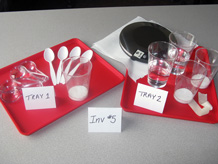
- 1 12oz clear plastic cup holding approximately 1 teaspoon kosher salt
- 4 magnifiers
- 4 plastic spoons
For each group (second set of materials, for dissolving salt in water):
- 1 digital scale
- 2 12oz clear plastic cups, each approximately 1/2 full (approx. 160g) of water
- 2 12oz cups, each holding 2 rounded teaspoons (approx. 20g) of kosher salt
- 2 paper towels
- 2 short pieces of masking tape
For each group (third set of materials, for use with mini-lakes):
- 2 12oz cups, each holding 2 rounded teaspoons (approx. 20g) of kosher salt
Note: Kosher salt, unlike typical table sat, contains no iodine or anti-clumping additives and so leaves water completely clear after it fully dissolves.
1. Ask the question
Students will continue to explore very tiny pieces of matter, pieces that can be smaller than most drops of water, and sometimes smaller than grains of sand. The substance they will investigate today is salt. Today's investigation also introduces transformation, or change, something students will continue to study throughout the curriculum, particularly transformations of water.
Today's investigation question is:
What changes and what stays the same when salt dissolves in water?
2. Explore
Before dissolving salt, students will spend a few minutes exploring it.
Note: Allow no more than 2 minutes for each of the explorations in this section.
Closely observe salt
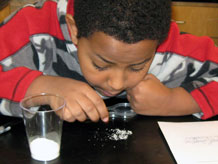
Distribute the first set of materials.
Have each student take a small pinch of salt from the cup, place it on the desk, and examine the grains with a magnifier. Encourage students to look for the tiniest grains they can find in their pinch of salt.
What do you see?
- differences in particle size; some much smaller than others
If students have closely observed table salt, they will notice that kosher salt does not have the same cubic form as table salt.
Transformation by crushing
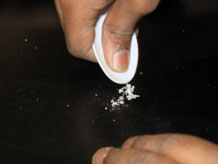
Demonstrate how to crush salt with the bowl of the plastic spoon without snapping the spoon, by pressing with a finger in the bowl of the spoon.
Have students crush the salt on their desks and inspect it again using their magnifiers. Ask students to look for the smallest pieces of salt they can find.
What changes and what stays the same when you crush salt?
- Particle size has decreased; some are very tiny.
- The number of particles has increased.
- The tiny pieces are still salt.
- The total amount of salt remains the same.
Do you think each grain of salt has weight? Even the tiniest pieces?
- Yes
How would you convince someone that a grain of salt has weight? How could you prove it?
- See the introduction to this session for a possible argument.
Do you think salt is matter? Why?
- Salt is matter because it has weight and takes up space.
3. Demonstrate dissolving
About Solutions
(background for teachers and not students)
When one substance dissolves in another, the resulting mixture, called a solution, is homogeneous - the concentration of each substance is the same throughout - and gravity will not cause the two substances to separate. Solutions do not appear cloudy.
Salt dissolves in water up to a point when the solution becomes saturated (38 grams of salt per 100 grams of room temperature water). Beyond the saturation point, excess salt will not dissolve; it will remain visible as grains of salt.
Salt or other dissolved solids will return to their solid state as water evaporates. Dissolving is reversible because the substances (in this case, water and salt) do not combine through a chemical reaction.
Cocoa does not dissolve in water; it remains suspended in the water for a period of time but eventually will settle to the bottom.
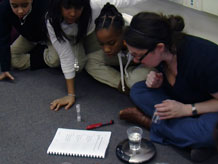
Remind students of the investigation question:
What changes and what stays the same when salt dissolves in water?
Are students familiar with the term dissolve? Ask for their ideas.
Pour 20 grams of salt into a 12oz cup half filled with water and stir.
- Taste might be helpful, but can't be done in school. (Also, taste cannot indicate how much of the original salt is still in the water.)
- Evaporate the water, but that will take a long time.
- Weigh the materials prior to and after dissolving the salt.
Once students understand that tracking the weights is the most reliable way to understand if dissolved salt is still in the water, they can move forward with their own exploration.
Note: Caution students to never to put anything in their mouths in class. Although the water, salt, and cups are probably clean and safe, do not taste.
4. Dissolve salt in water
Tracking dissolved salt using weight
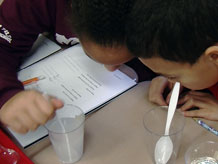
Distribute the second set of materials to the groups.
The Science Notebook page [What happens when salt dissolves in water?] will guide students through the process of weighing the water, salt, and the water with the salt added, and tracking changes in the volume.
- Review the concept of tare weight. Call attention to the tare weight of the cup, which you have posted.
- Show students where to put a piece of masking tape on the water cup so they can mark the water level before adding the salt.
- Review the notebook page that sets out the procedure for recording the weights. The weight data will be numerical (grams); the volume data will be visual (labeled drawings).
- Students will discuss their findings after they weigh their mini-lakes.
As students finish collecting and recording the data, collect the 12oz cups of salt water and have students get their mini-lakes.
Transforming mini-lakes to Salt Lakes
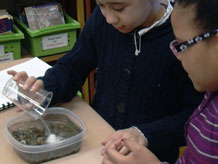
Students have probably heard about the Great Salt Lake in Utah. They'll now have the opportunity to transform their mini-lakes into Mini Salt Lakes by adding two teaspoons of salt.
Tell students they'll need to weigh their mini-lakes twice: once before adding the salt and once after adding the salt.
Distribute the third set of materials, 1 12oz cup holding approximately 20g of salt, to each pair.
Each pair:
- Weigh mini-lake and record weight in Science Notebook.
- Pour salt into mini-lake. Don't stir.
- Re-weigh mini-lake and record weight in Science Notebook. Add a note about addition of salt.
- Calculate the weight of the salt added to the mini-lake and record in Science Notebook.
5. Make meaning
Classroom Case


Explanation
The Role of Explanation Discussions
Available online at inquiryproject.terc.edu
Purpose of the discussion
The purpose of this discussion is for students to connect the investigation question with the weight and volume data they have collected. Based on their data, they make claims and describe the supporting evidence.
Claims and evidence: Introduce the scientific practice of supporting claims with evidence. Whenever students make a claim, they are expected to describe the evidence that supports the claim.
Evidence is data that supports or challenges a claim and is often in the form of a measurement or a drawing or photograph.
Sometimes the only way to support a claim is by reasoning. While reasoning is important, it is not always as convincing as actual data.
Example: I see that the scale reads zero when I put a grain of salt on it, but I know that a full container of salt weighs more than an empty container of salt, so I reason that each grain of salt must have some weight.
Students should also start to distinguish between evidence and their own ideas or opinions.
Engage students in the focus question
What changed and what stayed the same when the salt dissolved in water? What evidence supports your claim?
Possible responses include:
- The weight of the salt remains the same, even after it dissolved and the particles became too small to see. (Evidence: the combined weight of salt and water equals the sum of individual weights of the salt and the water).
- The salt continues to take up space, even after it dissolved and the particles became too small to see (Evidence: the combined volume of the salt and water is greater than the volume of just the water).
- Salt remains matter after it has dissolved and can no longer be seen. (Evidence: Dissolved salt has weight and takes up space.)
- The size of the salt grains changes, becoming too small to see. (Reasoning: The weight data lets us know that the salt is still in the water, and we know we cannot see the particles).
- The number of salt particles changes. (Reasoning: Data tell us that the weight of the salt remains the same. Since we reason that the particles have become smaller, there must be more of them.
Why do you think the salt is no longer visible? How do you explain this? (If not previously addressed)
- The salt particles became smaller and smaller as they dissolved until they became too small and too spread out to see. Like the dots on the 315 Dots per Page sheet, when tiny particles (or dots) are clustered they are visible but when they spread out enough, they become too hard to see.
Note: One might claim that the salt particles remain the same size but just become “invisible” in the water. Our sense of touch can provide evidence that the dissolved grains no longer exist at the same size.
Summarize the discussion and recap the investigation
Using the same language students have used, summarize their main ideas. Include the following key ideas:
- Remained the same: weight of salt, and the fact that the salt still takes up space (although actual volume was not measured)
- Changed: The salt is no longer visible. The grains became too small and too spread out to see when they dissolved.
As you recap the investigation, be sure there is understanding of these points:
- Students' work in this investigation highlights the importance of accurate measurements.
- When students make claims, they need to support those claims with evidence or with reasoning.
- Today's investigation provided evidence that:
- Weight stays the same as a substance dissolves.
- Things too small to see have weight and take up space.
- The concept of matter too small to see continues as a theme throughout the rest of this unit.


